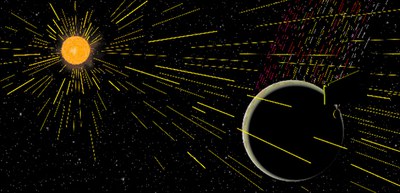
Carbon ions emitted from the Moon detected by KAGUYA
Could overturn prevailing theory on Moon formation
A research group led by Professor Kentaro Terada and Associate Professor Shoichiro Yokota of the Graduate School of Science of Osaka University has observed carbon ions emitted from the lunar surface by an ion mass spectrometer on the lunar orbiter KAGUYA. This finding strongly suggests that carbon has been there since the Moon’s formation.
It was believed that the Moon is more depleted in volatile elements, such as water and carbon (C), based on analyses of moon rocks brought to Earth by the Apollo program. The notion of a dry and volatile element-depleted Moon is one of the greatest premises behind the giant-impact hypothesis that the Moon was formed from the ejecta of a collision between the nascent Earth and a Mars-sized body and that volatile elements escaped and were lost to space.
However, in recent years, small amounts of volatile elements have been discovered from Apollo samples through advanced analyses. The existence of indigenous water in lunar materials has been supported through observations using neutron spectrometers and neutral mass spectrometers on lunar orbiters, while carbon was not observed by spaceborne instruments.
This group examined the emitted ions and photoionized exospheric particles, which were picked up by the electric and magnetic fields of the solar wind and collected by orbiters, and presented their observations of global and persistent C+ emissions from the lunar surface.
They estimated the amount of Ca+ fluxes, clarifying regional differences: the younger mares (or basaltic plains) emitted more carbon ions than older highlands. Secondary particles emitted from the surface and photoionized exospheric C+ are picked up by the solar wind and cosmic dust to space. However, in this group’s observations, carbon ions emitted from the Moon were distributed over almost the total lunar surface, but amounts differed with respect to lunar geographical areas.
The estimated emission fluxes to space were ~5.0 × 104 per square centimeter per second, which is greater than possible ongoing supplies from the solar wind and micrometeoroids. Their estimates demonstrate that indigenous carbon exists over the entire Moon, supporting the hypothesis of a carbon-containing Moon, where the carbon was embedded at its formation and/or was transported billions of years ago.
The giant impact model states that there were no volatile elements since the time of the moon’s formation (a volatile-depleted 'dry' Moon); however, recent research has revealed new theories of a volatile-contained “wet” Moon.
This group’s observation results will bring a shift from the giant impact model to a lunar formation model based on the presence of volatile elements.
Figure 1
Figure 2
The article, “KAGUYA observation of global emissions of indigenous carbon ions from the Moon,” was published in Science Advances at DOI: https://doi.org/10.1126/sciadv.aba1050.
